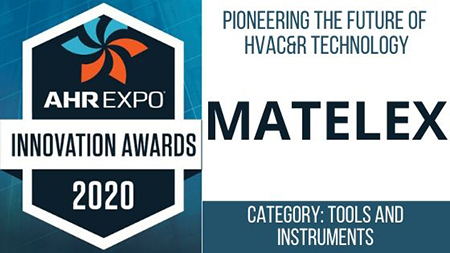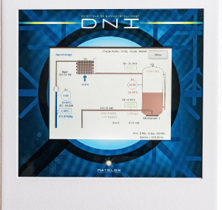

Leak Detection, Energy Management for Refrigeration Installations
Refrigerant leaks are hard to identify and even harder to know if they have been fixed.
During his 20-year career as a service manager, refrigerant leaks were a large part of his troubleshooting operation duties, said Gérald Anquetil, former professional refrigeration engineer and founder of MATELEX (Booth 2551).
The leakage rate, “was then around 20% to 30% per year, and it should be kept in mind that the refrigerants contained in these installations are greenhouse gases. Moreover, one leak can hide another, and we had no way of knowing it after our intervention,” he said.
So, he created a system that could permanently monitor refrigeration installations and remotely alert operators in the event of a leak. Anquetil patented a connected leak detection system in 2009. In 2020, MATELEX’s DNI (détecteur de niveau intelligent/smart level detector) is the winner of the AHR Expo Innovation Awards tools and instruments category.

The system measures pressure, temperature and refrigerant levels every two to three seconds and conducts a complete leak detection cycle every hour.
Until now, leak detectors have been used for direct detection such as measuring the refrigerant content in the air, said Marion Lazzarotto, marketing and business development manager for MATELEX. This method is limited because it is impossible to put detectors everywhere in areas such as external condensers and along pipes. These detectors also have limited detection zones, which are often distributed by drafts. But the DNI is based on indirect detection and alarm method, which activates as soon as the installation loses fluid regardless of the leak’s location.
This technique provides a suitable response to European regulatory requirements such as the EU’s F-Gas 517/2014. “In France, the effectiveness of leak detection by indirect measurement method has been widely recognized, so that it is now mandatory for installations containing more than 500 tonnes of CO2 equivalent,” she said.
The technique also serves as an energy efficient solution that monitors installation performance.
“This product is a real help to the industry. Not only does it save refrigerant and energy to reduce the global environmental impact of the installations, but it also drastically reduces the risk of breakdowns in the cold chain and the resulting operating losses,” said Anquetil and Lazzarotto.
The DNI system also helps operators identify system failures through a web interface called Sentinelle, which helps improve performances and reduce operating costs.
How Does It Work?
As the importance of environmental issues and high leakage rates in the refrigeration industry grow, MATELEX said the DNI is a useful tool for securing cold production and improving energy performance of thermodynamic installations while reducing carbon footprint.
Coupled with a remote monitoring web interface, the system constantly measures pressures, temperatures, refrigerant levels and more. The DNI is able to trigger the right alarm for leaks because algorithmic learning of the operation of the installation and gives alerts for, energy drifts and compressor failure with Sentinelle’s data analysis. The algorithmic learning is used for leak detection but it’s Sentinelle that analyses data alert in case of energy drift of compressor failure, according to MATELEX. The detector’s alerts help operators improve refrigerant installations’ performances while reducing energy consumption and lowering environmental impact.
“There are real challenges around direct emissions (refrigerant leaks) and indirect emissions (electricity consumption) and MATELEX is committed to making refrigeration more environmentally friendly, especially because the demand for refrigeration is always greater and all sectors must act,” said Anquetil and Lazzarotto.
The DNI benefits from its web interface—Sentinelle—that is facility monitoring that includes DNI data and comprehensive analysis tools that improve refrigerant installations’ performances. A map allows users to visualize leaking installations, and gauges share the leakage rate and the global environmental impact of the installations (TEWI), according to MATELEX. Lazzarotto said the Sentinelle web interface allows users to go beyond simple alerts in the event of a leak or energy drift. A panel of technical alerts to detect risks of compressor breakage or operating anomalies has been improved, so the system can remotely and in-real-time find operational; challenges.
How It Was Made
MATELEX was created ten years ago in France by Gérald Anquetil alone and specializes in expert electronic equipment—specifically leak check and energy management.
To develop an intelligent leak detector, Anquetil worked with an electronics research and consulting company that developed all the electronics around the product and some software programs. The consulting company started writing algorithms dedicated to learning how to operate an installation.
As a prototype was in the works, Anquetil and the consulting company became closer to end-users such as supermarkets. A major supermarket chain in France, the Auchan brand, contributed to help the product move forward in the testing phase, according to MATELEX. Together, the three entities tested, adapted and improved the product.
“Each refrigeration installation is different, as are its operating conditions. The main difficulty was therefore to adapt the product and the software part to a multitude of configurations—all unique—and to achieve the same goal: to detect leaks as quickly as possible,” said Anquetil and Lazzarotto.
Then a new player entered: Ademe—a public establishment of an industrial and commercial nature, placed under the supervision of the French Ministry of Ecological and Solidarity Transition and the French Ministry of Higher Education, Research and Innovation. Their partnership with MATELEX makes expertise and consulting capacities available to companies, local authorities, public authorities and the public.
In 2017, MATELEX joined the Dehon Group, whose Climalife company specializes in refrigerants for refrigeration and air conditioning businesses to support its national and international development.
For additional coverage of AHR Expo, visit ASHRAE Journal’s AHR Today web page.